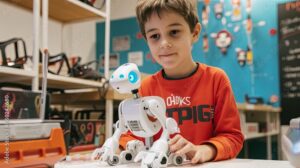STEM, Robotics, Coding & Maker Spaces——Not aware about at all

(photo by Adobe Stock)
Honestly, before watching the presentation given in the previous class by my friends, I was not aware at all of coding and maker space. They have used an innovative approach to build interest in this topic. I have just heard about ‘Coding’. As a language teacher, I know about language labs and my own technological devices used in the inculcation of the acquisition of language.
I understood after witnessing the presentation in the class that integrating STEM (Science, Technology, Engineering, and Mathematics), robots, coding, and maker spaces are crucial in today’s educational environment to help kids develop critical abilities like creativity, teamwork, and computational thinking. Because of the experiential learning opportunities these technology advancements offer, students are better prepared for their future employment. However, there are advantages and disadvantages to using these components in the classroom.
Students’ learning experiences can be greatly improved by including maker spaces, robots, and coding into the curriculum. These components encourage cooperation, creativity, critical thinking, and problem-solving. Additionally, they offer experiential learning experiences that can help make abstract ideas more relatable and intelligible. Students can prepare for a variety of potential occupations by using these tools to develop skills that are extremely relevant in today’s digital economy. Integrating STEM, robotics, coding, and maker spaces can help a lot of students, but it’s important to take into account different learning requirements and styles. Due to differing degrees of access to resources outside of the classroom or a lack of prior experience with technology, some students may face difficulties. Furthermore, pupils with diverse interests may not be as interested in these areas as others. Adopting inclusive teaching practices that accommodate all students is essential to guaranteeing that everyone has the chance to gain.

However, there are some common challenges for teachers who haven’t yet incorporated these technologies into their lessons. It could be a lack of trust in their ability to use them, restricted access to resources, inadequate training, and many more. Adding additional elements can also be difficult due to time restrictions and strict curricula. Implementation of these component’s success depends on recognizing and removing these obstacles.
Personally, as an educator, I love to add new things to my methodology of teaching. I keep myself updated with the new technological advancements. Teachers who have taught robotics, coding, or maker spaces found it to be a fulfilling and interesting experience. I believe that the experiential learning opportunities these technologies offer often encourage students. It can be challenging, though, as it calls for constant learning and adjustment to new resources and techniques. Overcoming obstacles and enhancing instructional techniques can be facilitated by peers exchanging experiences and best practices. Everyone’s experience can serve as support to overcome the barriers that come in the path of new learning factors.
I disagree with the statement, “Only “Techies” Should Teach Coding and Makerspace”. In my opinion, teaching coding or using maker spaces does not require strong technical expertise, however, it might be helpful. Any teacher can successfully incorporate these technologies into their lessons with the correct guidance and materials. The goal should be to create an atmosphere in which students and teachers can experiment, explore, and learn from one another. By introducing diverse viewpoints and abilities, interdisciplinary collaboration can also enhance the educational process.

(https://images.app.goo.gl/9hFasvGZdadD2gAA7)
Coding is a vital skill in today’s world. As technology pervades our daily lives, educators should empower students to innovate and create rather than just consume. Coding teaches problem-solving, risk-taking, and critical thinking, all within a safe environment that encourages learning from failure.
Teachers can gain a deeper understanding of the need to incorporate STEM, robotics, coding, and maker spaces into their lessons by reading these suggested texts and considering the related issues. This information can assist them in overcoming challenges, improving their methods of instruction, and eventually giving their students more engaging learning opportunities.

Hi Kavya
I know a lot of educators that are in STEM-related disciplines might be aware of coding. However, I think maker space is a common science corner or play corner we usually had classrooms back in those days. However, the introduction of technology has changed that concept of maker space into a digital one. I agree with you that the teaching of coding is beneficial and comes with its challenges. I think the first thing will be teachers understanding the basic concepts or fundamental terminologies used in coding and seeing how these principles are applicable in their subject area. Like I said during the presentation, those teaching languages, for instance, can use concepts of coding like sequencing a writing in their subject without necessarily using technology.
Hi Kavya, as a fellow language teacher, I can totally relate to your feelings! 🙂 Most of the things discussed in this week’s presentation were also brand new to me. At first, I even panicked – how should I write a blog post about something I just learned about? 😀 However, as soon as I started writing, everything just fell into place! And, just as you, I love trying out educational innovations and new methods, so it was a great learning experience for me.
Well said, Kavya! Its inspiring to see our openness to learning about coding and maker spaces, especially as a language teacher. You’ve well highlighted the value of these technologies in fostering critical skills like problem-solving, teamwork, and creativity among students. I love your emphasis on inclusivity and the importance of adapting teaching practices to accommodate diverse learning needs and styles. Your point about collaboration among educators to overcome challenges and learning and growing together as teachers, enriches the educational experience for everyone. I resonate with your stance that coding and maker spaces are not limited to ‘techies’ but are opportunities for all teachers to explore and innovate with their students.